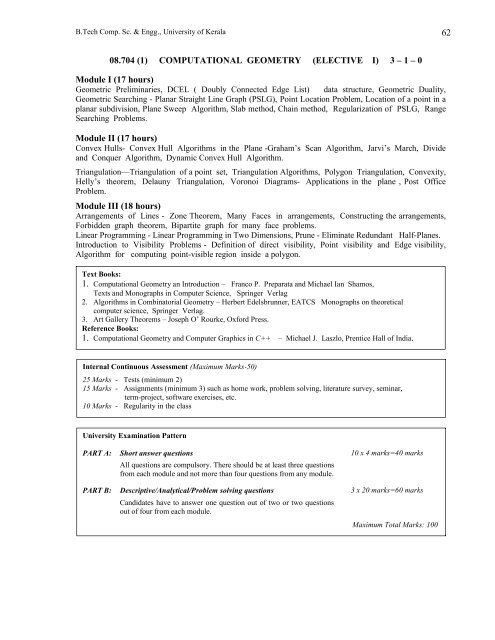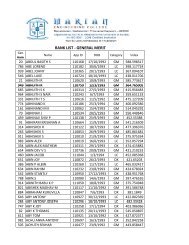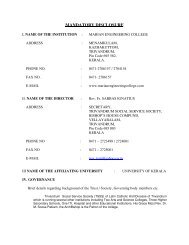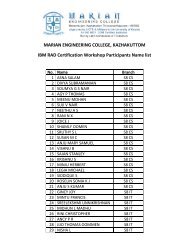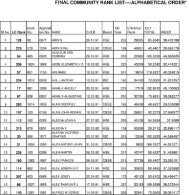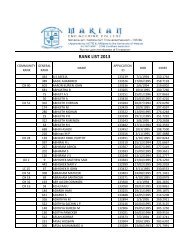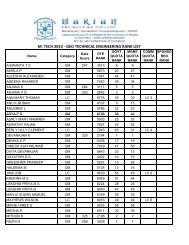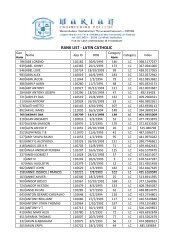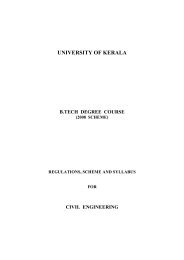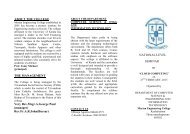UNIVERSITY OF KERALA - Marian Engineering College
UNIVERSITY OF KERALA - Marian Engineering College
UNIVERSITY OF KERALA - Marian Engineering College
Create successful ePaper yourself
Turn your PDF publications into a flip-book with our unique Google optimized e-Paper software.
B.Tech Comp. Sc. & Engg., University of Kerala 62<br />
08.704 (1) COMPUTATIONAL GEOMETRY (ELECTIVE I) 3 – 1 – 0<br />
Module I (17 hours)<br />
Geometric Preliminaries, DCEL ( Doubly Connected Edge List) data structure, Geometric Duality,<br />
Geometric Searching - Planar Straight Line Graph (PSLG), Point Location Problem, Location of a point in a<br />
planar subdivision, Plane Sweep Algorithm, Slab method, Chain method, Regularization of PSLG, Range<br />
Searching Problems.<br />
Module II (17 hours)<br />
Convex Hulls- Convex Hull Algorithms in the Plane -Graham’s Scan Algorithm, Jarvi’s March, Divide<br />
and Conquer Algorithm, Dynamic Convex Hull Algorithm.<br />
Triangulation—Triangulation of a point set, Triangulation Algorithms, Polygon Triangulation, Convexity,<br />
Helly’s theorem, Delauny Triangulation, Voronoi Diagrams- Applications in the plane , Post Office<br />
Problem.<br />
Module III (18 hours)<br />
Arrangements of Lines - Zone Theorem, Many Faces in arrangements, Constructing the arrangements,<br />
Forbidden graph theorem, Bipartite graph for many face problems.<br />
Linear Programming - Linear Programming in Two Dimensions, Prune - Eliminate Redundant Half-Planes.<br />
Introduction to Visibility Problems - Definition of direct visibility, Point visibility and Edge visibility,<br />
Algorithm for computing point-visible region inside a polygon.<br />
Text Books:<br />
1. Computational Geometry an Introduction – Franco P. Preparata and Michael Ian Shamos,<br />
Texts and Monographs in Computer Science, Springer Verlag<br />
2. Algorithms in Combinatorial Geometry – Herbert Edelsbrunner, EATCS Monographs on theoretical<br />
computer science, Springer Verlag.<br />
3. Art Gallery Theorems – Joseph O’ Rourke, Oxford Press.<br />
Reference Books:<br />
1. Computational Geometry and Computer Graphics in C++ – Michael J. Laszlo, Prentice Hall of India.<br />
Internal Continuous Assessment (Maximum Marks-50)<br />
25 Marks - Tests (minimum 2)<br />
15 Marks - Assignments (minimum 3) such as home work, problem solving, literature survey, seminar,<br />
term-project, software exercises, etc.<br />
10 Marks - Regularity in the class<br />
University Examination Pattern<br />
PART A: Short answer questions 10 x 4 marks=40 marks<br />
All questions are compulsory. There should be at least three questions<br />
from each module and not more than four questions from any module.<br />
PART B: Descriptive/Analytical/Problem solving questions 3 x 20 marks=60 marks<br />
Candidates have to answer one question out of two or two questions<br />
out of four from each module.<br />
Maximum Total Marks: 100


